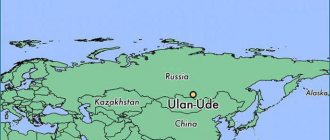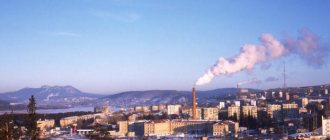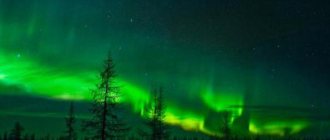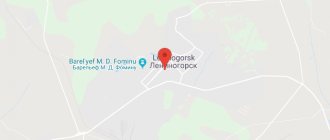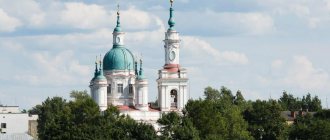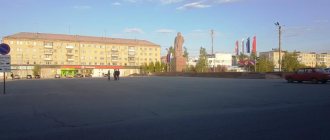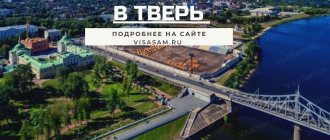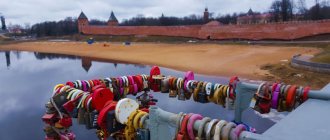Year of foundation: 859
The date of the city day is unique for each year.
In 2021,
this date is
September 11
.
In 2021, due to the pandemic, mass events in honor of the city day are canceled or may be postponed
Novgorod Detinets (Photo: Preto Perola, Shutterstock)
Velikiy Novgorod
- Russian city, administrative center of the Novgorod region, City of Military Glory. It is located in the north-west of the country, on the Ilmen lowland, on the Volkhov River, not far from Lake Ilmen.
This is one of the oldest and most famous cities in Russia, founded in 859
.
In the Middle Ages it was the center of the Novgorod land, known as " Mr. Veliky Novgorod
".
The period of the political history of the Novgorod land from 1136 - a sharp limitation of the role of the prince - until the victory of the Moscow prince Ivan III over the Novgorodians in 1478, is usually called the “Novgorod Republic”.
St. Sophia Cathedral is located within the walls of Detinets (Photo: Boonsom, Shutterstock) Veliky Novgorod has gone through many difficult periods in history. In the winter of 1569-1570, an army of guardsmen, personally led by Ivan the Terrible, set out on a campaign against Novgorod, the reason for which was a denunciation and suspicions of treason. All the cities along the road from Moscow to Novgorod were plundered; along the way, Malyuta Skuratov personally strangled Metropolitan Philip in the Tver Adolescent Monastery.
The number of victims in Novgorod was huge, from 27 thousand (in 1546 the city had only 35 thousand population). The defeat in Novgorod lasted 6 weeks, thousands of people were tortured and drowned in Volkhov. The city was plundered. The property of churches, monasteries and merchants was confiscated. In 1611-1617 Novgorod was subjected to Swedish occupation and was completely devastated. By the end of the occupation, several hundred inhabitants remained in the city.
During the Great Patriotic War, the city was occupied from August 15, 1941 to January 20, 1944 and was almost completely destroyed. The restoration of the city was led by the famous architect Alexey Viktorovich Shchusev.
Monument to Alexander Nevsky (Photo: Art Konovalov, Shutterstock)
On June 11, 1999, the President of the Russian Federation signed the federal law “On the renaming of the city of Novgorod, the administrative center of the Novgorod region, into the city of
Veliky Novgorod
.” In October 2008, Veliky Novgorod was awarded the title “City of Military Glory”.
Veliky Novgorod has preserved many monuments of ancient Russian architecture. The most ancient of them is the Hagia Sophia
, whose construction began in 1045.
It is located inside Detinets
- the historical center of the city.
In the very center of Detinets in 1862 the monument “ Millennium of Russia”
", representing in sculptural compositions the main stages of the development of Russian statehood and culture, outstanding figures of history, science, literature and art, from the 10th to the 19th centuries. The authors of the project are sculptors Mikhail Mikeshin and Ivan Schroeder and architect Victor Hartman.
Monument “Millennium of Russia” (Photo: Vitaly Ilyasov, Shutterstock)
Since 1999, the famous
Rurik settlement
, a trade, craft and military-administrative center of Priilmenye, an archaeological monument of the 9th century, has been included in the city limits. It is located 2 km south of the center of modern Veliky Novgorod, at the source of the Volkhov River from Lake Ilmen (opposite the Yuriev Monastery). It was the residence of the Novgorod princes, with which many names of famous political figures of Ancient Rus' are associated. Alexander Nevsky spent his childhood here, Dmitry Donskoy, Vasily Temny, Ivan III and Ivan the Terrible stayed here. At different times, there were 6 wooden and stone churches located on the territory of the settlement.
In 2009, Kino, with the participation of Kino, created the documentary film “Mister Veliky Novgorod”.
The population of the city is about 225 thousand people (2020).
Day of the city
Veliky Novgorod celebrates in June, but in 2021 the festive events have been postponed to September.
General information
The area of the municipality is 90 square kilometers. The founding date of the city is considered to be the 9th century. Veliky Novgorod is rightfully considered the stronghold of Russian statehood. It was in it that Rurik was called to reign. In the Middle Ages, the city headed Novgorod Rus', and later served as an important economic and political center of the country.
At the beginning of the 16th century, the population of Veliky Novgorod decreased significantly. The city was captured by Swedish troops. In 1700 he was released. It was included in the St. Petersburg province. Later he headed the Novgorod region. At that time, there were no large industrial complexes in the city. Therefore, exiles were sent to the populated area.
During this period, the population density of Veliky Novgorod was minimal. The city began to develop and grow after the end of World War II. Today it is a beautiful and modern settlement. It is divided into the following districts:
- Station.
- "White City".
- West.
- Grigorovo.
- Trade city.
- Center.
- Pskovsky.
- Krechivitsy.
- Trubichino.
- Pankovka.
- Syrkovo.
History of origin
The first settlers - the Ilmen Slovenes - appeared on the hill between the lake and the river in the 8th century and built a fortress, which in modern times is called Rurik's settlement. The history of the city is connected with Prince Rurik, whom the Novgorodians called to reign in order to stop civil strife, as reported in The Tale of Bygone Years. Rurik’s power extended far; he distributed surrounding lands to their husbands, while he himself ruled in Novgorod.
Population
In 2005, the municipality had a population of 219,000. In 2010, this figure decreased to 218,717. In 2014 it was 219,971. In 2017, the population of Veliky Novgorod reached 222,594 people. The minimum number of citizens was noted in 2009. The maximum peaks occurred in 2010 and 2015. According to statistics, the municipal center has a population of 2,400 people per square kilometer. Local residents are usually called Novgorodians, and women Novgorodians.
Politic system
What is characteristic of the political system of the Novgorod state? Power in the republic was exercised by the prince, who was chosen at the assembly from the neighboring principalities. Such a ruler was responsible for the judicial system in his lands, as well as for defense and military power. He largely depended on the vecha - a popular meeting of prominent city men.
The veche was endowed with great powers. It chose the prince and judged his actions, elected the head of the city and military commanders, created laws and regulations, established taxes and their amounts.
In addition to city offices and the people's assembly, the republic had a supreme chamber, or council of lords, consisting of an archbishop, a mayor, a thousand and several elders.
The population was divided into: townspeople (who had the right to buy city land), boyars (representatives of the upper class), living people (small landowners), merchants, black people (artisans, workers, small traders), villagers (various types of peasants).
Demographic situation
The population of Veliky Novgorod shows a gradual natural decline. The number of deaths exceeds the number of babies born. In 2016, 10,736 people died in the region. A total of 7,204 children were born. The difference was colossal. On average, about twenty children are born in the region every day. More than thirty people die. Leaves the region 33. Migration cards are issued to 34 foreign nationals.
The population of Veliky Novgorod is directly affected by the incidence of the following diseases:
- pathologies of the circulatory system;
- oncological neoplasms;
- cardiac dysfunction;
- cerebrovascular abnormalities.
Transport and accidents account for about 17%. The proportion of suicides and cases of alcohol poisoning exceeds 12%. More than thirty babies under the age of one die every year. The main reason is pathologies of fetal development and maternal illness. Congenital anomalies account for 22%.
The average migration increase is 360 people per year. About a thousand people leave for permanent residence in large populated areas of the North-Western region. There are 370 Nizhny Novgorod residents remaining in the Central District. The Southern Federal District elects approximately one hundred citizens. They also go to the Volga region, the Urals, Siberia and the Caucasus. The maximum migration increase was registered from Ukraine. However, in 2021 it decreased by 12%. This trend continues today. A large number of migrants come from Uzbekistan and Tajikistan.
Due to the lack of jobs, Veliky Novgorod remains attractive only to people of retirement age. The settlement boasts a unique architectural heritage and excellent recreational conditions. Social infrastructure is developed at the proper level. The region has a resettlement program for ethnic Russians coming from the countries of the former USSR. In Veliky Novgorod there are 25 people from Uzbekistan and approximately 20 residents of Kazakhstan. They are provided with assistance in finding work and providing housing. Financial assistance is provided.
Economic relations
The main economic factor in the Novgorod principality was not land, but capital. And although the majority of the state’s residents were engaged in agriculture, fishing and hunting, most relations were built on trade (both external and internal). Novgorod stood on the trade route from Scandinavia to Byzantium and was an important part of the “Varangian route”.
In addition, the city was famous for its crafts. For example, about 215 blast furnaces were built here, where 503 blast furnaces smelted iron. The metal was processed by blacksmiths, the total number of whom reached 130 people.
Also in the Novgorod principality they were engaged in salt making, pearl mining, and the manufacture of jewelry and locks. The city was famous for its woodworking, leather, shoe, and iron ore craftsmen, as well as weavers, potters and other artisans.
Age groups
The population of Veliky Novgorod is represented by three groups. The first category includes persons under fifteen years of age. Their share is 20%. The second consists of pensioners. Their number approaches 30%. Approximately half of the city's residents are able-bodied. The trend of aging society, which began at the end of the 20th century, continues to persist. The average age of the population of Veliky Novgorod exceeds 35 years.
Historical Center
As you know, Veliky Novgorod was formed from several settlements neighboring each other, these are:
- Nerevsky end. Residential area located in the northern part of the Sofia side, on the left bank of the Volkhov River. It was inhabited by ancient Narova tribes or Finno-Ugric lay people. The first mentions of the settlement are found in 1067 (“Novgorod Fourth Chronicle”) and in 1172 (“Novgorod First Chronicle”).
- Slavensky end. The area of the ancient city, which received its name from the ancient village of Slavna. It has been mentioned in chronicles since 1231, while information about Slavna can be found in written sources starting from 1105.
- Lyudin's end (or Goncharsky). The area was located in the southwest of Detinets (the powerful fortress of Veliky Novgorod). Early mentions of this village date back to the 1120s (birch bark charters) and 1194 (numerous Novgorod chronicles).
Education
On the territory of the city there are schools, kindergartens, vocational schools, higher educational institutions and branches of the capital's universities. Specialties from economics and law faculties are traditionally in greatest demand among local applicants. There is an increase in interest in engineering and technical professions.
The cultural life of the region is provided by theaters and museums, art galleries and exhibition centers. The authorities of Veliky Novgorod regularly organize mass celebrations and conduct excursion events designed for guests and residents of the city.
Rurik's Settlement
The settlement under Rurik very soon became a large trade and military center with well-developed administration. His squad and relatives settle on fertile lands. “Overseas guests” come here often and for a long time.
According to the chronicle, the Dowager Princess Olga came to Gorodishche, who wanted to unite Rus' under the banners of the princes of Kievan Rus. Until the end of the 10th century, the Settlement played an important political and commercial role, and life was in full swing here. Later archaeological excavations discovered many treasures of Byzantine and Arab coins, which testified to the vigorous trading activity of the Settlement.
In the middle of the 11th century, construction began on a great temple in the lower reaches of the river. When the Hagia Sophia was built, the palm in the development and history of the city passed to it. From now on, spiritual and political power is concentrated here, and a complex of religious buildings is being built. Life in Gorodishche is becoming sad, there is no former scope, and the new settlement around the cathedral complex is called “Novo-Gorod” - life here is in full swing. It becomes the center of social life for the villagers. The settlement retains the title of a princely and later imperial residence.
Composition of the population of Veliky Novgorod
Today, representatives of many nationalities live in the municipality. The dominant ethnic group has traditionally been Russians. In the Nizhny Novgorod region their number exceeds 560,000 people. In recent years, the number of Ukrainians has increased several times. Gypsies, Belarusians, Armenians, Tatars, Azerbaijanis, and Uzbeks are registered in the city.
Also living are Moldovans, Chechens, Germans, Tajiks, Chuvashs, Mordovians, Georgians, Koreans and Jews. The minority includes Lezgins, Poles, Finns, Kazakhs, Latvians, Estonians and Udmurts.
Sights and famous people of the city
Unlike new housing, there are plenty of attractions in the city - not a single Russian city has preserved so many ancient monuments. More than 50 monuments of ancient Russian architecture have become part of the modern city.
Start your acquaintance with the city with the ancient Kremlin (Detinets) and its towers. Climb the Kokuy Tower, where the observation deck is located, and you will immediately see the architecture of the city, the picturesque surface of Lake Ilmen, and see a clear division of the city on both banks of the river. Next to the ancient Kremlin there is a beautiful park with entertainment, tennis courts, and a concert venue.
The dominant architectural feature and symbol of the city is the St. Sophia Cathedral with a complex of church buildings on the banks of the Volkhov. It was founded by Yaroslav the Wise in the image and likeness of the Kyiv Cathedral. It was also built by Kyiv craftsmen.
Next to the cathedral is the “Millennium of Russia” monument, built in 1862, which will tell you about the heroic pages of history.
Among the outstanding people of the Novgorod land:
- Writers and historians
- Scientists and travelers
- Composers and artists
- Heroes of the Soviet Union
These are dozens, hundreds of famous people who glorified their region. It cannot be otherwise: the city’s rich history, talented people.
Social protection
There are federal and local programs for material support for the poor in the region. Help is provided to large families, disabled people and young parents. To fully replenish the natural population decline, immigrants from other countries are invited. They are paid an allowance. Employees of employment and social protection services in Veliky Novgorod provide assistance in finding a job.
Health camps have been created for children, which operate not only in summer, but also in winter. First-graders from socially vulnerable families receive a full set of stationery and school supplies. Disabled people and pensioners have the right to additional care. They are visited by nurses and medical workers. Requests from representatives of these groups of the population of Veliky Novgorod are given priority by city utility workers.
Industry
Industrialization of the region is showing positive dynamics. The largest enterprises in the region include plants engaged in the processing of natural raw materials and mining.
In every settlement of the Novgorod region there are factories producing dairy products, bakery products and meat delicacies. There is a workshop for assembling cabinet and upholstered furniture. The production of electronic equipment has been established. A chemical plant is in operation.
Population of Veliky Novgorod: size, composition, average age, employment and social protection on News4Auto.ru.
Our life consists of everyday little things that in one way or another affect our well-being, mood and productivity. I didn’t get enough sleep - my head hurts; I drank coffee to improve the situation and cheer myself up - I became irritable. I really want to foresee everything, but I just can’t. Moreover, everyone around, as usual, gives advice: gluten in bread - don’t go near it, it will kill you; A chocolate bar in your pocket is a direct path to tooth loss. We collect the most popular questions about health, nutrition, diseases and give answers to them that will allow you to better understand what is good for your health.
Unemployment
According to official figures, the unemployment rate in the region is at 2%. This parameter is 0.5% higher than the average. Currently, more than two thousand able-bodied people are registered with the Center for Labor Protection. At the same time, the number of vacancies is two times less. The unofficial level of employment in Veliky Novgorod is much lower. The number of unemployed people who have not registered with the Employment Center is in the thousands.
All of them are in the care of their relatives or have unstable income. These are mainly seasonal workers, housewives, independent entrepreneurs who are engaged in entrepreneurial activities without registering as an individual entrepreneur or establishing a legal entity.
List of the most popular specialties in the city:
- medical workers;
- sellers;
- teachers and education staff;
- drivers;
- installers.
There are always open vacancies for engineers and loaders, cooks, qualified seamstresses, and orderlies.
On average, the employment rate in the city and its subordinate region does not exceed 40%. This figure is lower than the regional coefficient. The government of the Novgorod region is developing programs aimed at increasing jobs and employing the maximum number of citizens.
Standard of living and finances
The average salary is higher than in the regional centers of the Central Federal District. It is about 30 thousand rubles. This level has been exceeded in modern industrial enterprises:
- JSC Acron - production of mineral fertilizers
- CJSC "Novgorod Metallurgical Plant" - processing of scrap metal, production of copper wire
- LLC "Dirol-Cadbury" - production of chewing gum
- Distillery
It is noteworthy that almost all large enterprises in the city have vacant jobs.
The revenue side of the budget for 2014 is 4.6 billion rubles, but the expenditure side is 300 million more. During the year, the expenditure portion of the treasury exceeds the 10 percent allowed by the budget code, and we have to resort to large loans, increasing the public debt.
